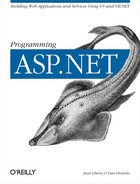In
the previous example, you bound an
ArrayList of strings to the list box. Often, you will want to bind
objects more complex than strings. For example, you might imagine a
Book class that has properties such as title,
ISBN, and price, as shown in Example 9-3 (C#) and
Example 9-4 (VB.NET).
Example 9-3. The Book class in C#
public class Book
{
public Book(float price, string title, string ISBN)
{
this.price = price;
this.title = title;
this.isbn = ISBN;
}
public float Price { get {return price;} }
public string Title { get {return title;} }
public string ISBN { get {return isbn;} }
private float price;
private string title;
private string isbn;
}Example 9-4. The Book class in VB.NET
Public Class Book
Private _Price As Double
Private _Title As String
Private _ISBN As String
Public Sub New( _
ByVal thePrice As Double, _
ByVal theTitle As String, _
ByVal theISBN as string)
_Price = thePrice
_Title = theTitle
_ISBN = theISBN
End Sub
Public ReadOnly Property Price( ) As Double
Get
Return _Price
End Get
End Property
Public ReadOnly Property Title( ) As String
Get
Return _Title
End Get
End Property
Public ReadOnly Property ISBN( ) As String
Get
Return _ISBN
End Get
End Property
End ClassYou add the new book objects to the ArrayList, just as you assigned the strings, shown here in C#. (The VB.NET code is the same except without the semicolons.)
bookList.Add(new Book(49.95f, "Programming ASP.NET","100000000"));
bookList.Add(new Book(49.95f,"Programming C#","0596001177"));
bookList.Add(new Book(34.99f,"Teach Yourself C++ In 21
Days","067232072x"));
bookList.Add(new Book(24.95f,"Teach Yourself C++ In 24
Hours","0672315165"));
bookList.Add(new Book(12.99f,"TY C++ In 10 Minutes","067231603X"));If you are going to bind a collection of Book objects to the list box, you must tell the list box which property to bind to, so that it will know which property to display. You do this by adding the following lines indicated in boldface to the page’s HTML source:
<asp:DropDownList ID="ddlBooks" autopostback="True"DataTextField="Title"DataValueField="ISBN"Runat="server"></asp:DropDownList>
The DataTextField
attribute assigns the property that
will be displayed in the list box, while the
DataValueField
attribute
assigns the property that will be held in the
value attribute of the list box item. When you run
this and examine the source through the browser, you find that
ASP.NET has translated the ASP controls to the appropriate HTML as
follows:
<option value="100000000">Programming ASP.NET</option> <option value="100000000">Programming C#</option> <option value="067232072x">Teach Yourself C++ In 21 Days</option>
Change the label to display the ISBN along with the title:
lblMsg.Text = "Selected: " + ddlBooks.SelectedItem.Text +
"(" + ddlBooks.SelectedItem.Value + ")";or in VB:
lblMsg.Text = "Selected book: " & ddlBooks( ).SelectedItem.Text _
& " (" & ddlBooks( ).SelectedItem.Value & ")"The result is that the user selects a book and the book title and ISBN are displayed, as shown in Figure 9-2.

